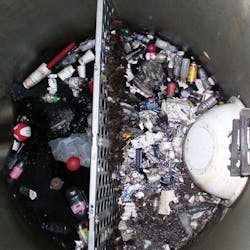St. Paul Stops Storm Water Sediment & Trash
St. Paul, Minn., began a city-wide program of upgrading its storm water quality facilities in 2010. Several areas of the city (St. Albans, Victoria and Beacon Bluff) were selected for a monitoring program initiated by the city of St. Paul and WSB & Associates. The focus of the study is a pretreatment structure upstream of the Beacon Bluff infiltration system, which captures a 143.6-acre drainage area.
To preserve the service life of a portion of the infiltration system, engineers installed a 72-in.-inner-diameter pretreatment manhole with a 10-ft-deep sump and an 18-in.-inner-diameter pipe in and out. Also installed in the structure were a model 7246 SAFL baffle from Upstream Technologies Inc. (UTI) and a model 30R Snout from Best Management Products Inc. (BMP).
The SAFL baffle, a stainless steel baffle developed at the St. Anthony Falls Laboratory (SAFL), is designed to reduce the turbulence inside a storm structure, which can resuspend captured sediment, reducing the efficiency of sumped structures in high-flow events. Verified total suspended solids reductions in excess of 80% can be realized using the SHSAM sizing software utilized by UTI and BMP. The Snout reduces floatable trash and debris along with surface oils; the solids can occupy extremely large storage volumes, presenting a maintenance burden that reduces the storage capacity of any storm water facility.
The Beacon Bluff installation was monitored from Oct. 14, 2011, through Sept. 28, 2012. More than 130 cu ft of sediment were removed. Floatables removals were observed and estimated at above 85%, with several cubic yards of floatable trash and debris being removed. More than 65,000 Snouts and more than 700 SAFL baffles have been installed in North America.
Download: Here






